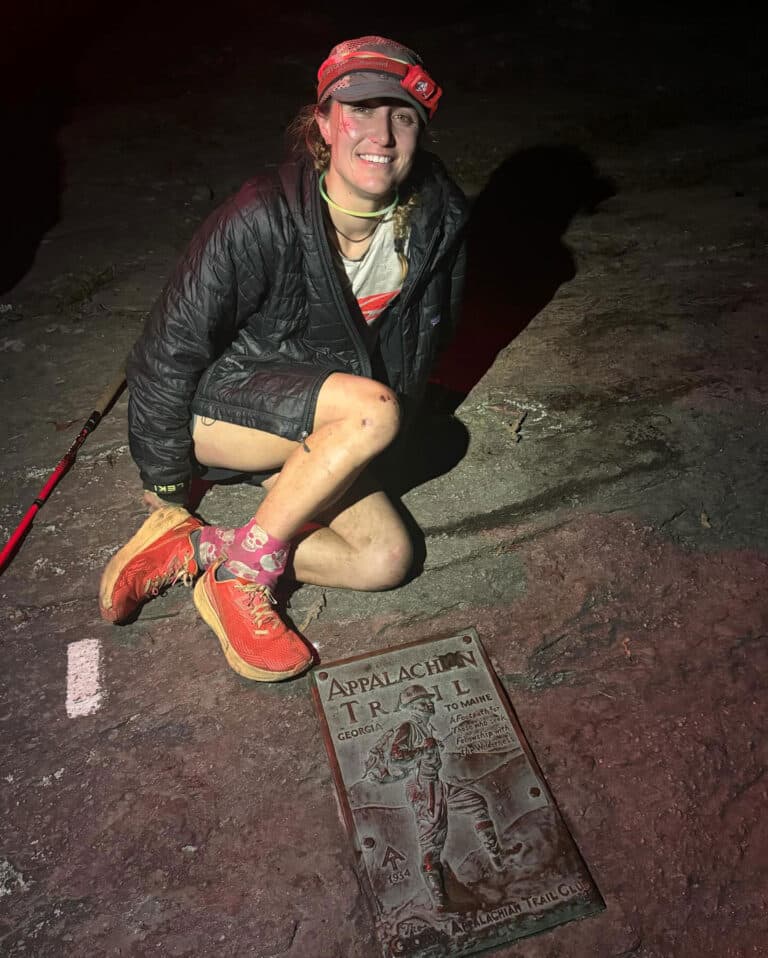Roll down the windows, turn up the tunes, and hit the road. We have scoured the Southeast and Mid-Atlantic for the most affordable adventures.
Explore Underground
Mammoth Cave, Kentucky
It’s hard to believe that Mammoth Cave, the longest cave system in the world, started 10 million years ago as nothing more than a seeping, soggy limestone-laden field. To date, more than 400 miles of the cave’s passages have been explored since the first tour of Mammoth in 1816. The cave has seen an interesting array of curious characters in its time—natives and trappers, soldiers and doctors, miners and priests—yet even now, the cave and its true extent are hardly understood. Mammoth is, as early guide Stephen Bishop once put it, “a grand, gloomy, and peculiar place.”
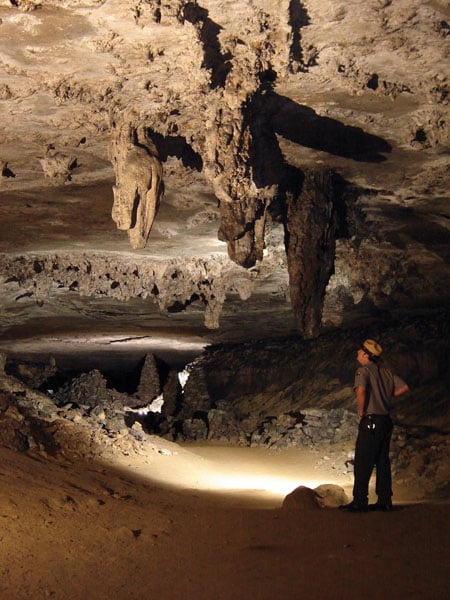
Above ground, though, the land surrounding Mammoth Cave is fertile and green. Some 84 miles of backcountry trails for hikers, equestrians, and bikers showcase the park’s 52,000+ acres, which include the scenic river valleys of the Green and Nolin Rivers. Mammoth received its national park designation in 1941, and because of its rich ecosystem above and below ground, became a World Heritage Site in 1981 and an International Biosphere Reserve in 1990.
Take a tour down Gothic Avenue ($12), where you can see some graffiti left by visitors who visited Mammoth Cave in the 1800s. It sounds bizarre, and it is, but so goes the history of Mammoth. After your tour, pitch a tent along the banks of the Green or stake your claim on one of the Nolin’s islands with a free Backcountry Use Permit. Permits are available at the Visitor Center and give visitors free range to settle most anywhere throughout the park. Anglers especially will enjoy the riverside location, as muskellunge, bluegill, catfish, bass, perch, and crappie abound.
For $26, you can take an Introduction to Caving Tour to discover if spelunking is really for you. Over the course of three hours, you’ll learn the basics of caving and experience the cave as early explorers might have seen it. If you enjoy camping but prefer to have a few amenities during your stay, the Houchin Ferry Campground just 15 miles away offers 12 sites at $12 per night.
Go beyond the typical tourist experience and sign up for the Wild Cave Tour ($55). You’ll only travel a total of five miles, but you’ll be underground for six hours climbing, army-crawling, and squeezing into all of those hard-to-reach chambers and labyrinths the other tours merely talk about. To get the full Mammoth Cave experience, reserve a room at the Mammoth Cave Hotel (rates from $89 per night). In its heyday, the hotel hosted a grand ballroom and covered porticos that would impress even the haughtiest of visiting aristocrats.
Scale a Sumit
Seneca Rocks, West Virginia
Along the eastern edge of West Virginia’s Monongahela National Forest lies 100,000 acres of rugged mountain ridgelines that rise like fins above the North Fork Valley. Collectively, these ridges form the Spruce Knob-Seneca Rocks National Recreation Area. Established in 1965, this area was the first National Recreation Area designation under the Forest Service. Spruce Knob, West Virginia’s highest point and the Allegheny Mountains’ tallest peak, looms 4,863 feet above the valley floor. Its erosion-resistant Pottsville sandstone features are pockmarked with stripes and circles, indicative of its more than 300-million-year lifespan. The climate here is harsh and unlike anywhere else in Appalachia. Arctic-like plants and wildlife like the dwarf cornel, red fox, snowshoe hare, and ruffed grouse thrive here, yet are more commonly found in Canada’s coniferous forests.
Just 15 miles north of Spruce Knob stands Seneca Rocks, which has long been recognized as a Mid-Atlantic climbing hotbed. The iconic flake of Tuscarora quartzite rises 900 feet above the North Fork River and is revered for its exposed ridgelines and caprock. Purchased by the federal government in 1969, Seneca Rocks was once the site of the only low altitude assault climbing school for the U.S. Army in the early 1940s. Chosen for its terrain, which was similar to that found in northern Italy, World War II soldiers learned tactical rope and alpine assault techniques on Seneca and nearby Champe Rocks. Today, climbers can still find World War II-age pitons jammed into the rock face, which explains how one section of cliff was donned “The Face of a Thousand Pitons.”
With roughly 400 established climbing routes ranging in difficulty from 5.0 to 5.13, climbers can easily spend a season at Seneca and never climb the same route twice. There are only a few bolts along these routes, so climbers should be well versed in traditional climbing. Not a climber? Hop on the West Side Trail behind the Seneca Rocks Discovery Center. A three-mile hike out-and-back, this trail leads to the very summit that climbers access. To see Seneca from afar, hop on the Spruce Knob trail and summit the state’s highest point. There’s an observation tower at the summit, and the easy walk from the car can be done in a 0.5-mile loop. Set up camp at Seneca Shadows Campground (sites from $17 per night) for stunning views of Seneca’s rocky face.
Not far from Spruce Knob and just outside the National Recreation Area is NROCKS (“N” for Nelson), a privately owned climbing area that features one of only three via ferratas on the East Coast. Built in 2002, the via ferrata (Italian for “iron road”) takes visitors up 1,085 feet in elevation, across a suspension bridge that is 150 feet high and 200 feet long, and at exposed heights of 280 feet. NROCKS offers guided via ferrata tours starting at $80 per person, and you can even stay onsite after your day on the rock. Stake your tent for $7.50 per person, per night, or reserve a cabin for $20 per person, per night. NROCK also has a number of guest rooms that can accommodate four people and are $81.25 per night.
Rally a few friends with an equal sense of adventure and hire a guide out of Seneca Rocks Mountain Guides. For a group of three at minimum, visitors with little climbing experience can scale the summit of Seneca under professional supervision and assistance for $90 per person. Later, post up shop at the Seneca House just five miles from Seneca Rocks. Rooms start at $45 per night, but there is also a sweet renovated barn available for just $75 a night. Whatever adventures you decide to embark on, a stop at Harper’s Olde General Store and Front Porch Restaurant is a must.
Raft the Canyon
Albright, West Virginia
Not everyone has the time or skills to tackle the Grand Canyon, but that’s no excuse to forgo paddling through a river canyon altogether. The Cheat River Canyon in northern West Virginia is one of the longest commercially rafted rivers in the Mid-Atlantic. A classic example of West Virginia whitewater, the Cheat Canyon is one of the few naturally running rivers in the state that remains, with high-volume, big-wave action around every bend.
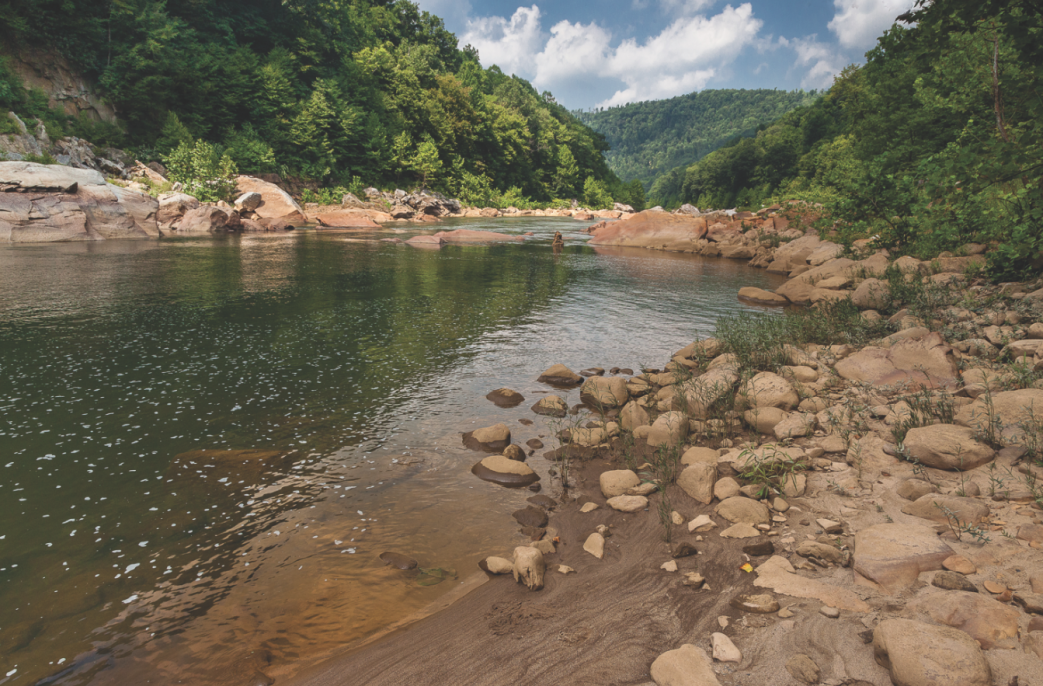
Of the river’s 162-mile journey north along the Allegheny Mountains, the 10-mile class III-IV stretch from Albright, W.Va., to its confluence with the Big Sandy is the most popular section. Here, the steep gorge walls plummet to the river’s edge like heavy green curtains, housing a wide array of delicate and diverse species of flora and fauna. More than ten endangered, threatened, or globally rare species occur in the canyon, including the flat-spired three-toothed land snail, which exists nowhere else in the world.
Once listed on American Rivers’ 10 most-endangered rivers in the nation due to acid mine drainage blowouts in the mid-‘90s, the Cheat River is now both protected and restored. In 2014, The Nature Conservancy and The Conservation Fund designated more than 3,800 acres along the banks of the Cheat as official Wildlife Management Area, securing in perpetuity a wild and wonderful canyon for generations of paddlers to come.
Bring your own boat, run your own shuttle, and be home in time for supper! Though the Cheat has a remote and wild feel, the river is just a three-hour drive from Washington, D.C., making a day trip easily doable. In the event that you need an affordable and convenient spot to crash, the Cheat Canyon Campground offers flat, grassy, riverside camping for $5 per person, per night. Cap off the day with a $4 burger and a Preston County draft from the newly established Brew Ha Ha Caffeine and Cuisine in downtown Kingwood.
Never been on whitewater before? Lacking proficient river-reading skills? Hop in a raft and let a hired guide do the work. Wilderness Voyageurs offers guided rafting trips down the Cheat Canyon for $75 during the weekday, $95 on Saturday, and $85 on Sunday. If it’s your first time on whitewater, or you have younger kids along, consider a float down the five-mile class II-III Cheat River Narrows first. Blackwater Outdoor Adventures offers trips down the Narrows for $52.95, which includes lunch. Be sure to come during the spring when river levels are high. After your float, head an hour north past the Pennsylvania border to the quaint town of Ohiopyle where Wilderness Voyageurs is headquartered. You can camp at Benner’s Meadow Run Camping & Cabins for $9 per person, per night, and prime yourself for another day of adventure. Hundreds of miles of mountain biking and hiking trails like the Great Allegheny Passage, Laurel Highlands Trail, and Sugarloaf Trail System are right out your tent flap, so grab some boots or rent a bike for $6 per hour and get exploring!
If your wild and wonderful whitewater adventure maxed out your ruggedness for the day, there are a number of cabins and B&Bs in the area. Some unique options are the Riverside Hotel (rates from $69 per night) in Friendsville, Md., and Blue Moon Rising (cabins starting at $175 per night) in McHenry, Md. The Riverside Hotel is literally riverside, located on the banks of the Upper Yough (another great class IV-V stretch of whitewater, which you can raft with Wilderness Voyageurs for $120). For $12, the Riverside also serves vegetarian “all you care to eat” meals made from local, organic ingredients and vegetables grown in their backyard. Blue Moon Rising prides itself on sustainability and earth-friendly construction practices, so you can feel good about your lodging for the evening. Choose from any of their 13 unique cabins, all of which are built from reclaimed materials. Be sure to make time to enjoy a meal at Blue Moon’s partner business, MoonShadow Café, in nearby Accident, Md., for farm fresh food, craft brews, and live entertainment.
Paddle With Dolphins
Cumberland Island, Georgia
Running for 18 miles along the coast of Georgia, and ranging anywhere from one-half to three miles wide, Cumberland Island is the state’s largest and southernmost barrier island. An enchanted destination, Cumberland’s 36,545 acres are only accessible by ferry. The island features 50 miles of hiking trails that wind through old growth maritime forests, interior wetlands, marshes, and pristine beaches.
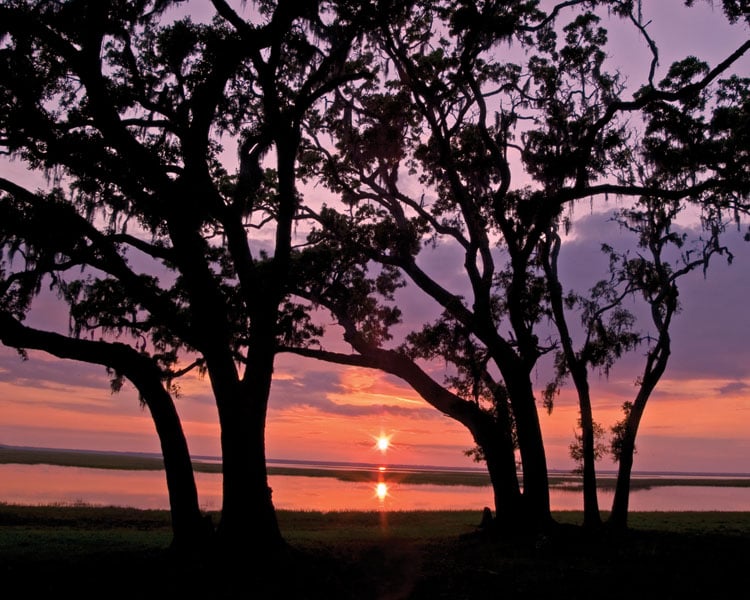
Endangered loggerhead sea turtles nest on Cumberland Island. Though nearly 10,000 acres of the northern half of the island are a designated Wilderness Area, young turtles are still at risk from feral hogs, raccoons, boats trawling offshore and vehicles driving along the beach. It is estimated that only one of every 10,000 sea turtle hatchlings is likely to reach maturity.
While some of the 50,000 annual visitors to the island hire a guided vehicle tour run by the National Park Service, the most authentic way to experience Cumberland is to walk beneath its towering 400-year-old live oak trees and feel its pearly white sand beneath your feet.
You could catch the ferry from St. Marys ($15 roundtrip, 45 minutes one way), but why not take your own boat and paddle the seven miles yourself? Up the Creek Xpeditions in St. Marys offers sea kayak rentals for $40 per day if you don’t have your own. Launch from Crooked River State Park’s boat ramp (one-time $5 parking fee) and wind through tidal creeks toward Sea Camp. It will take a couple of hours of solid paddling to cross, but the resident dolphins here may reward you with a sighting, if you’re lucky. Once you strike land, stake your tent at Sea Camp ($4 per person, per night) or hike to one of the backcountry sites like Brickhill Bluff. The park’s entrance fee is $4 for adults 16 and older, and private boaters can pay at Sea Camp upon arrival.
Join Up the Creek Xpeditions on a full-day guided sea kayaking tour to the southern end of the island for $100 per person. Keep in tune with your earthly adventures after the paddle by booking a stay at The Hostel in the Forest. Just 10 miles west of Brunswick, Ga., this alternative, eco-friendly hostel has tree houses, an organic vegetable garden, a sweat lodge, and hiking trails that braid across the property’s 133-acre forest. Initial membership to the hostel is $10, after which members can stay for $25 per night.
Land a Lunker
Shenandoah National Park, Virginia
Just 75 miles from Washington, D.C., Shenandoah National Park provides an easily accessible recreational haven for urban residents throughout the Mid-Atlantic. There are 500 miles of trails throughout the park’s 200,000 acres, including 101 miles of the Appalachian Trail. For 105 miles, Skyline Drive runs the length of Shenandoah like a backbone, providing visitors roadside access to trailheads, overlooks, and camping. The rolling ridgelines, rocky terrain, and bucolic meadows characteristic of Shenandoah attract hikers, anglers, and historians alike. More than 70 mountain streams and tributaries host a healthy and diverse fish population, including the native brook trout. Despite heavy visitation numbers to the park (1.2 million in 2015 alone), there is plenty of solitude and adventure to be found in Shenandoah’s peaks and valleys.
While you might not necessarily land a lunker, Big Run is the largest watershed area in Shenandoah and also one of the best places to drift a fly for native brookies. Nonresidents can get a freshwater fishing license for Virginia at $8 per day, or $21 for five consecutive days, and entrance into Shenandoah is typically $20 per vehicle for a seven-day pass. Once in the park, you can hike to Big Run from the Doyles River trailhead. In general, the harder you’re willing to work, and the more you hike in, the higher your chances of catching the elusive brookie! Grab a free backcountry camping permit at any one of the self-registration kiosks to pitch a tent along Big Run, or head up to Loft Mountain Campground where you can stay for $15 a night.
Freshen up your casting skills before you head to the woods with a two-hour class courtesy of Mossy Creek Fly Fishing out of Harrisonburg, Va. For $85, you’ll receive rods, reels, flies, and tackle free of charge, not to mention top-of-the-line advice from Mossy Creek’s expert guides. Shack up at Old Rag Cottage just a few miles from Old Rag and Whiteoak Canyon. The cottage can be rented at $85 per night and puts you practically streamside for a full day of fishing.
The park’s namesake river is revered for its smallmouth bass, which live in greater densities on the Shenandoah than any other river in Virginia. If high catch rates are what you’re after, look no further than the South Fork of the Shenandoah. Mossy Creek offers eight-hour float trips down the Shenandoah for $325 per day, including food and beverages. Afterwards, you can settle into a luxury yurt at Rose River Farm (rates from $250 per night for a four-person maximum occupancy), which is just a few minutes’ drive from other native trout waters like the Rapidan, the Upper Rose, and the Robinson.
Sleep with Gators
Fargo, Georgia
Don’t let the presence of gators deter you from taking a visit to Georgia’s Okefenokee National Wildlife Refuge (after all, there are only 15,000-some alligators living in the Okefenokee Swamp). And don’t let the fact that Okefenokee is a swamp alter your decision, either. Swamps can be sweltering hot, dark, muddy, and buggy, yes, but they can also be magical, teeming with life and wonder. Distinguished by Seminole Indians as the “Land of Trembling Earth,” which alludes to its unstable peat deposits, Okefenokee is the largest blackwater swamp in the country. For nearly 700 miles from southeastern Georgia to a small part of northern Florida, the Okefenokee provides sanctuary to more than 200 species of migratory birds as well as black bears, gopher tortoises, and of course, the American alligator. The swamp also protects the headwaters of the St. Marys and Suwannee Rivers. In 1971, Okefenokee was recognized as a Wetland of International Importance because of its size—within the 400,000-acre refuge itself, over 350,000 acres are designated wilderness, making the swamp one of the largest intact freshwater ecosystems in the world.
Also located in the refuge is the Stephen C. Foster State Park, an 80-acre facility located on the banks of the Suwannee. It serves as the western entrance to the Okefenokee and an educational hub for the park. The best time to visit Okefenokee is March through April, when wildflowers are in bloom, the water is high, and temperatures are bearable. November through February is also ideal, as mosquito populations are typically down while migratory bird numbers are up.
Planning ahead and preparing is key if you want to experience Okefenokee by boat. The refuge allows a limited number of canoe permits per season, and permits are often reserved months in advance ($6 non-refundable reservation fee + $15 per person, per night). There are 120 miles of Wilderness trails within the refuge, so the possibilities are endless. The six color-marked canoe trails can easily be worked into multiday canoe excursions ranging from day trips to four-night outings. Bring your own boat and launch at any one of the park’s boat ramps, or rent a kayak or canoe from Okefenokee Adventures (rates from $25 per day). You can arrange a shuttle with the outfitter if you plan to be out for more than a day. There are seven overnight shelters built and three islands available for camping in the swamp.
Explore the tangled forest of longleaf pine, cypress, bay, and shrubs via the comfort of a 24-foot Carolina Skiff. The guides at Okefenokee Adventures are extremely knowledgeable about the swamp’s cultural and natural history, as well as its resident plant and wildlife populations. A 90-minute tour costs $19.50 for adults, but we recommend taking advantage of the sunset tour for a truly magical glimpse at Okefenokee ($28.50). Book a campsite at Stephen C. Foster State Park (sites from $28 per night) for everything you love and cherish about the swamp without the logistical hassle of backcountry camping.
If delicately cruising along in a motor-powered boat doesn’t match your ethics, you can still get a guided Okefenokee excursion that’s longer, more in-depth, and human-powered. Okefenokee Adventures offers four-hour tours by canoe and kayak and only costs $95 for two people. Just 18 miles up the road from the state park is the Suwannee River Eco-Lodge. There are 10 cottages available for rent starting at $85 per night.
Dive Below Waterfalls
Brevard, North Carolina
Transylvania County in western North Carolina has long been touted as the “Land of Waterfalls,” and rightfully so—over 250 waterfalls in varying heights and flows pockmark the county’s mountainous terrain. Between Gorges State Park, DuPont State Forest, and Pisgah National Forest, visitors to Transylvania have 100,000 acres of public lands, 400 miles of singletrack, and more than 1,000 miles of gravel forest service roads at their fingertips. At the heart of Transylvania, cradled between Pisgah and DuPont, is the quaint town of Brevard. With close proximity to recreational gems like Looking Glass Rock and the Blue Ridge Parkway, it’s no wonder Brevard has attracted a core community of active outdoor enthusiasts. Be it climbing, paddling, cycling, fishing, trail running, and more, Transylvania County is more than the Land of Waterfalls—it’s the Land of Adventure.
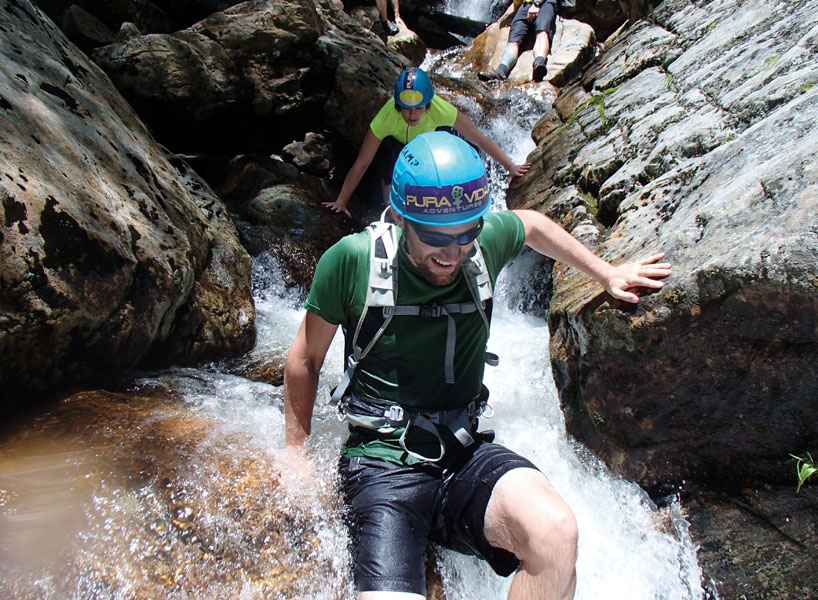
Looking Glass Falls is likely the most iconic waterfall in the area, and also one of the most heavily visited. With roadside access, this 60-foot waterfall is normally crowded on any given weekend, so try to check it out early in the day to avoid the masses. Take a quick dip in the falls before heading up Forest Service Road 475B. Be on the lookout here for roadside camping, which is free and available on a first come, first serve basis. Once you’ve staked your claim on a site, veer off 475B and explore Slick Rock Falls and Sliding Rock. Sliding Rock especially can get busy during the summer, but it’s a classic water destination and plus, it’s just plain fun.
To see more waterfalls in less time, go for a run or hop on a bike and weave your way through DuPont State Forest’s 90-mile trail system. You can run or ride to a waterfall, take a dip, wash, rinse, repeat. Bridal Veil Falls, Triple Falls, High Falls, and Hooker Falls are some of the best in DuPont. Bring your own bike or rent one from The Hub in Pisgah Forest, N.C., (rates from $35 per day). You can also hire a guide and set up basecamp at The Bike Farm, where two people can get a half-day guided tour and a campsite for $85 per person. Upgrades to the lodging here include platform camping ($35 per night) and tent glamping ($100 per night).
If your idea of adventure in the Land of Waterfalls involves more than splashing off in the pools, Pura Vida Adventures’ canyoneering trips are for you. Participants must have some prior rappelling or climbing experience, because this trip is full on for six to nine hours. Beginner canyoneering courses start at $150 per person while intermediate trips come in at $225 per person. When you’re ready to retire, nearby Davidson River Campground offers primitive sites starting at $18 per night, or, for the luxuries of home, check out the dog-friendly cabins at DogWoods Retreat (cabins starting at $275 per night).
Ride Like the Pros
Greenville, South Carolina
The city of Greenville hardly gets the biking notoriety that other two-wheeled meccas like Boulder and Portland receive, but for decades, this southern city has been turning out some of the world’s best riders. Take George Hincapie, for example, a 17-time Tour de France rider and three-time U.S. National Road Race Champion. After retiring from his career as a professional road rider, Hincapie returned to his hometown. Not far from Greenville is the up-and-coming community of Travelers Rest, affectionately referred to as “TR.” Travelers Rest sits at the northern terminus of the Greenville Health System (GHS) Swamp Rabbit Trail, a 21-mile greenway connecting TR to Greenville. On any given day, riders and pedestrians along the GHS Swamp Rabbit Trail can catch glimpses of the Hincapie Racing Team gearing up for a training ride out to Paris Mountain State Park, Caesar’s Head State Park, or Table Rock State Park.
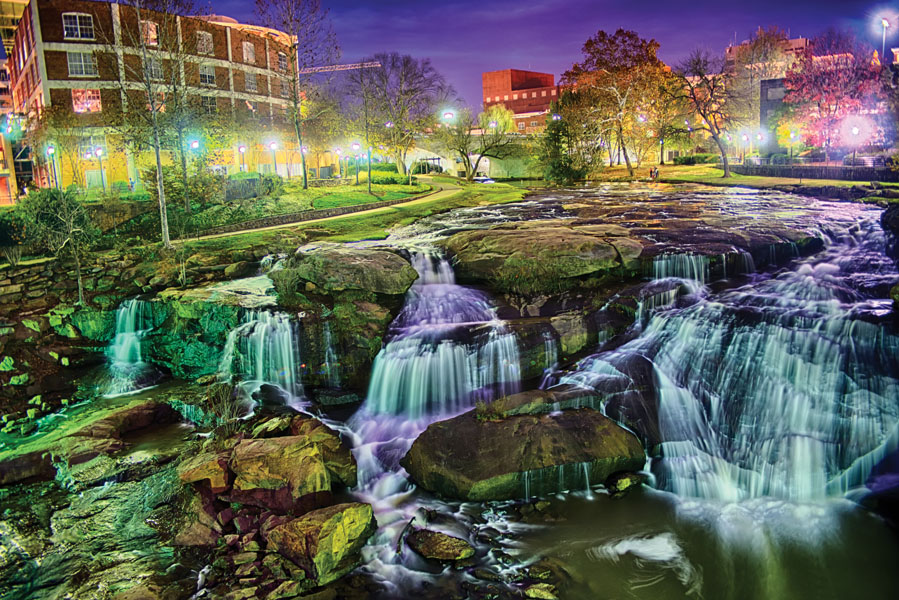
Cycle along the Reedy River via the GHS Swamp Rabbit Trail, the famed Rails-to-Trails pathway of Greenville and Travelers Rest. The going is relatively flat and paved, which makes it great for families and novice riders alike. Don’t have a bike of your own? Sunrift Adventures in Travelers Rest offers rental rides starting at $20 per half day. Camp out nearby at Paris Mountain State Park, where you’ll have 15 miles of hiking and biking trails just a short walk from your campsite. Basic sites here start at $18 per night, but you can also camp along the North Lake Trail Loop for $11 per night.
Bike and brunch with Reedy Rides in downtown Greenville. This guide and rental service offers two-wheeled tours of Greenville as well as informational tours of the Swamp Rabbit Trail. For $45 you can get a four-hour tour and brunch with Reedy Rides, but you can also customize your trip, so ride longer, explore more, and get the most out of your Greenville cruise. Post up for the evening at the Swamp Rabbit Inn just two blocks off Main Street in downtown Greenville. Rooms here start at $105 per night, and the Inn even has its own bike rental program through The Bike Shed, which offers rides at $25 per eight hours.
For more beta on Greenville’s bike-friendly scene, pick up a copy of Cycling Greenville ($14.95), which details 20 of the best rides in and around Greenville. You can venture on your own or learn from the pros by enlisting the services of George Hincapie’s guides at Hotel Domestique. Rates here start at $100 for a one- to three-hour tour, but these guides aren’t necessarily into the tourist thing. They’ll push you harder on climbs and unveil local routes, give you pointers and pace the downhills. Were it not for the upscale accommodations at Hotel Domestique, which include a three-course European style breakfast and saltwater lap pool starting at $295 per night, you might think you were at training camp.
Search for the Stars
Linville Gorge, North Carolina
The Linville Gorge Wilderness is the crown jewel of Pisgah National Forest. The 12,000-acre wilderness is largely regarded as one of the few remaining places in the Eastern seaboard where one can find solitude on a weekend, cliff-edge views, and truly wild terrain to boot. The Linville River bisects the wilderness, and though the upper and lower reaches of the Linville are calm and flat, there are nearly seven miles of continuous class IV-V+ rapids in the heart of the gorge. The towering 2,000-foot cliffs that rise from the river are littered with hidden caves you won’t find on any map, yet are well known among climbers and off-trail hikers. Though the gorge is stunning any time of year, come in the spring when cliffsides are covered in the pink of rhododendron-in-bloom.
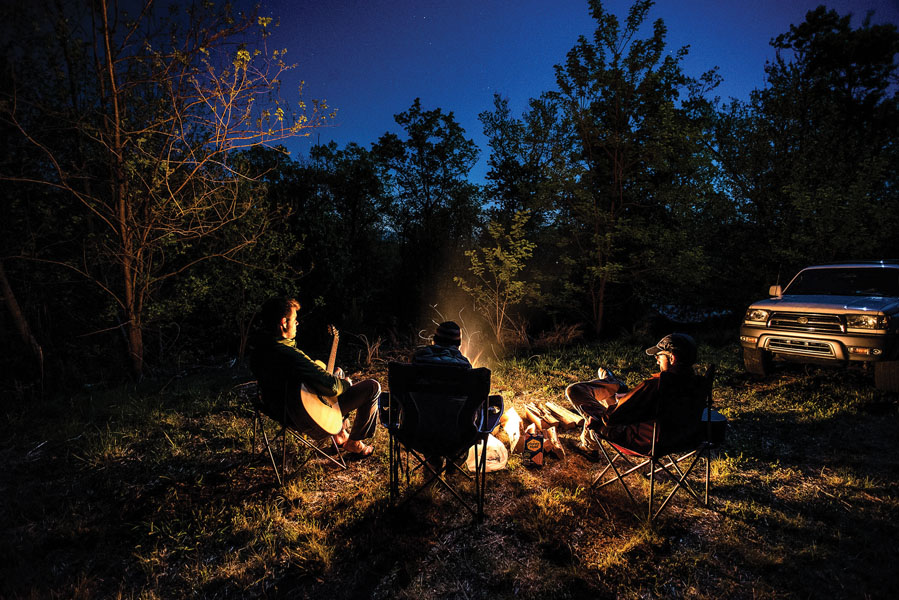
On weekends and holidays during peak season (May through October), you’ll need to reserve a camping permit ahead of time. Though the permit is free, users can only receive one permit per month for three consecutive days and two nights. The view from Shortoff Mountain is truly spectacular, and if you can snag one of the campsites along the way, you’re in for a real celestial treat.
As with any wilderness area, the trails in Linville aren’t marked and some areas in particular are hard to navigate or overgrown. Let a guide show you the way. HikeMore Adventures offers a stargazing excursion ($75 per person) to the Linville Gorge with Bob Hampton, President and Founder of the Blue Ridge Astronomy Group and Future Director of the Blue Ridge Public Observatory. Spend four hours under the stars with the knowledge and guidance of an expert. Accompanying the trip will be a 13.1″ diameter Dobsonian Reflecting Telescope to help you see the planets, moons, and satellites that speckle our nightsky.
To know and feel the grandeur and ruggedness of the gorge, consider tackling the 22-mile Linville Gorge Loop Trail. HikeMore can lead the way. Starting at $225 per person, this trip can easily cater to individual preferences and physical abilities. Consider packing a Tenkara rod so you can take advantage of the 13 miles of pristine fishing on the Linville River. By the time you finish this loop, your body will likely need a little TLC. Recharge and get a hot shower at the newly opened Harmony Hostel ($45 per person per night) just an hour north in Banner Elk, N.C.
Go Thru, All the Way
Chattanooga, Tennessee
Though Chattanooga is the fourth largest city in the state of Tennessee, its proximity to the outdoors has revitalized the reputation of this southern metropolis. Once considered the dirtiest city in America, Chattanooga is now thriving on its recreational assets like the Tennessee River, which flows through the middle of town, and adjacent public lands like Prentice Cooper State Forest and North Chickamauga Creek Conservancy. Situated against the towering Cumberland Plateau, Chattanooga is widely recognized for its sandstone bluffs and boulders. From climbing to IRONMANs and everything in between, Chattanooga has it all.
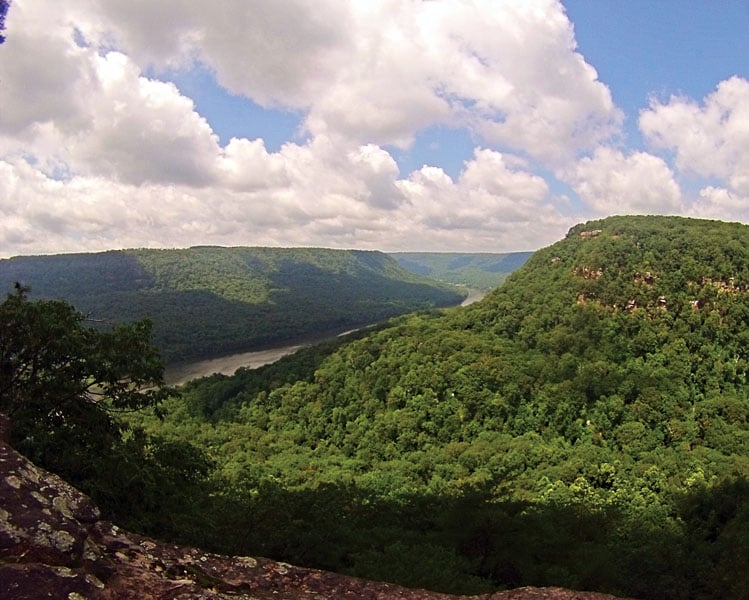
Thru-hike or run the Cumberland Trail. Officially designated in 1998 as the Justin P. Wilson Cumberland Trail State Park, the trail is Tennessee’s first linear state park and is a significant section of the newly developed Great Eastern Trail. At 190 miles, this scenic trail is still being developed, but the southern terminus of the trail ends just outside Chattanooga at Chickamauga-Chattanooga National Military Park on Signal Mountain. When completed, the Cumberland Trail will connect two national parks and passes through a National Wild and Scenic River area. Hikers and trail runners alike will be surprised at the ruggedness of this trail, which follows high ridgelines and deep gorges. There are few developed campsites along the trail, so most of the land is fair game so long as Leave No Trace principles are practiced and respected.
The Tennessee River Blueway, designated a National Scenic River Trail in 2002, highlights all that is unique about Chattanooga. From Chickamauga Dam to Nickajack Dam, the Blueway runs for 48 miles past downtown, through the Tennessee River Gorge, and into the Nickajack’s headwaters. Paddlers can opt for a day trip and still get a taste of the gorge by putting in at Suck Creek and taking out six miles downstream at Pot Point. L2 Outside offers boat and SUP rentals starting at $25 per day, though if you come on a Tuesday, you’ll only pay half. The Blueway runs through both private and public land, but there are plenty of campsites along the way that are free and open to the public. Outdoor Chattanooga offers a comprehensive list of every campsite, cabin, and hotel along the Blueway for ease of logistics.
The adventurous soul will attempt the Blueway in its entirety, which can easily be completed in three days. For a different glimpse of the Tennessee River, L2 Outside leads sunset paddles ($35) every Friday and Saturday night from 8:00 to 9:30 pm. Your board will come equipped with LED lights to brighten your way as you paddle downstream. In the evening, retreat to your perch, literally, above Lookout Creek, a seasonal wetland in the Reflection Riding Arboretum and Nature Center. Known as Paddler’s Perch, this treetop cabin is mainly reserved for paddlers of the Tennessee River Blueway who can rent the space for $35 per night for two people.
Hang Ten
Outer Banks, North Carolina
The Outer Banks is a series of barrier islands that runs for 200-some miles along the Atlantic Coast from southeastern Virginia through North Carolina. Known as the “Graveyard of the Atlantic,” the coast and waves along the Outer Banks have long warranted respect from both sailors and surfers. Its past is peppered with shipwrecks and pirates, settler mishaps and aviation exploits. Before tourism trickled into the Outer Banks in the early 1930s and 1940s, the islands here were quiet and wild, with more barren sand dunes and dense maritime forest than boardwalks and development. You can still get a taste of the Outer Banks’ origins at the many national wildlife refuges that dot the seaboard like Currituck and Pea Island.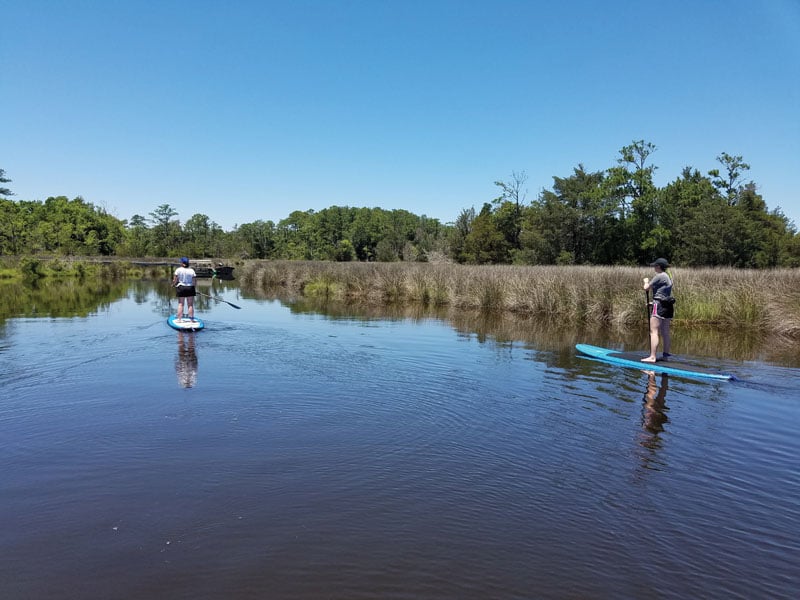 Take the free ferry from Hatteras Island to Ocracoke Island, a 16-mile long barrier island that is partially protected under the Cape Hatteras National Seashore. The beaches here are undeveloped with a small clustering of restaurants and shops 13 miles from the ferry landing. Rent a surfboard from Ride the Wind Surf Shop for $22 a day or $75 for the week. Camp among the open sand dunes at Ocracoke Campground for $28 per night. Separated by barrier dunes, your site is oceanside so you can conveniently access the waves when the gettin’s good.
Take the free ferry from Hatteras Island to Ocracoke Island, a 16-mile long barrier island that is partially protected under the Cape Hatteras National Seashore. The beaches here are undeveloped with a small clustering of restaurants and shops 13 miles from the ferry landing. Rent a surfboard from Ride the Wind Surf Shop for $22 a day or $75 for the week. Camp among the open sand dunes at Ocracoke Campground for $28 per night. Separated by barrier dunes, your site is oceanside so you can conveniently access the waves when the gettin’s good.
The Outer Banks are great for surfing, sure, but if getting thrashed in the waves all day starts to get old, the vast amounts of protected lands and wetlands host some of the best flatwater paddling on the East Coast. Learn about the barrier island ecosystem and wildlife population on a two-hour kayak tour through the Kitty Hawk Maritime Forest. Duck Village Outfitters offers guided tours for $39 for single kayaks, $69 for double. The Adventure Bound Campground in Kitty Hawk not far away has a campground for roughing it (rates at $28 per tent for max two people, per night) but you may want a bed and a kitchen. Check out their hostel and reserve a private room for $60 per night.
Learning a sport as an adult takes a lot of humility, patience, and humor. Farmdog Surf School in Nags Head makes the sometimes-painful process of learning to surf more fun than ego-busting. Sign up for the shop’s three-day adult surf camp for $249. Farmdog also offers an all-women’s yoga, surf, and SUP camp for the same price. After your day on the water, check out Farmdog’s espresso bar, which also sells organic smoothies and sandwiches, all the ingredients you need for an awesome day. Find a little bit of “seaclusion” from the Nags Head scene at Pelican Cottages, where you can rent a seaside cabin starting at $135 per night.

